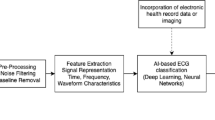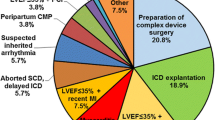Abstract
Background
The wearable cardioverter defibrillator (WCD) is an important tool in mitigating sudden cardiac death (SCD). The WCD provides patient alarms for detected arrhythmias or electrical noise/artifact. Some patients experience frequent alarms for artifact. We sought to evaluate the effects of a novel artificial intelligence algorithm to reduce alarms related to electrical noise or artifact (advanced arrhythmia discrimination algorithm, AArD).
Methods
A retrospective review of a large commercial database of prescribed WCD. Patients prescribed the WCD during the years 2017 (discrimination algorithm, DA group) or during 2019 (advanced arrhythmia discrimination algorithm, AArD) were analyzed. A total of 96,000 patients were sampled, 48,000 in the control group (using standard direct algorithm, DA) and compared to 48,000 in the intervention AArD (4000 per group per month) for 12 months. The AArD further discriminates ECG signals based on a machine-learning algorithm utilizing intensity and frequency beyond the standard DA. Outcomes regarding alarms, arrhythmias, and safety were analyzed.
Results
The AArD algorithm was associated with a significant decrease in frequency of alarms over the course of WCD use; 54% of patients in the AARD versus 27% of DA had 0 alarms (P < .001). In the entire cohort, there was a 56% relative reduction in alarms with the use of AArD. Appropriate arrhythmia treatment time was not significantly different between the groups (44 s DA vs 45 s AArD [p = ns]).
Conclusions
A novel artificial intelligence algorithm reduces alarms without delaying appropriate therapy for VT/VF. These changes may improve compliance and quality of life in patients with a WCD.




Similar content being viewed by others
References
Zheng ZJ, Croft JB, Giles WH, Mensah GA. Sudden cardiac death in the United States, 1989 to 1998. Circulation. 2001;104(18):2158–63. https://pubmed.ncbi.nlm.nih.gov/11684624/.
Rea TD, Pearce RM, Raghunathan TE, Lemaitre RN, Sotoodehnia N, Jouven X, Siscovick DS. Incidence of out-of-hospital cardiac arrest. Am J Cardiol. 2004;93(12):1455–60. https://pubmed.ncbi.nlm.nih.gov/15194012/.
Feldman AM, Klein H, Tchou P, Murali S, Hall WJ, Mancini D, Boehmer J, Harvey M, Heilman MS, Szymkiewicz SJ, Moss AJ. Use of a wearable defibrillator in terminating tachyarrhythmias in patients at high risk for sudden death: results of WEARIT/BIROAD. Pacing And Clin Electrophysiol. 2004;27(1):4–9. https://pubmed.ncbi.nlm.nih.gov/14720148/.
Chung MK, Szymkiewicz SJ, Shao M, Zishiri E, Niebauer MJ, Lindsay BD, Tchou PJ. Aggregate national experience with the wearable cardioverter-defibrillator: Event rates, compliance, and survival. J Am Coll Cardiol. 2010;56(3):194–203. https://pubmed.ncbi.nlm.nih.gov/20620738/.
Kutyifa V, Moss AJ, Klein H, Biton Y, McNitt S, MacKecknie B, Zareba W, Goldenberg I. Use of the wearable cardioverter defibrillator in high-risk cardiac patients data from the prospective registry of patients using the wearable cardioverter defibrillator (WEARIT-II registry). Circulation. 2015;132:1613–9.
Kutyifa V, Moss AJ, Klein HU, McNitt S, Zareba W, Goldenberg I. One-year follow-up of the prospective registry of patients using the wearable defibrillator (WEARIT-II Registry). PACE - Pacing Clin Electrophysiol. 2018;41(10):1307–13. https://pubmed.ncbi.nlm.nih.gov/29992590/.
Olgin JE, Pletcher MJ, Vittinghoff E, Wranicz J, Malik R, Morin DP, Zweibel S, Buxton AE, Elayi CS, Chung EH, Rashba E, Borggrefe M, Hue TF, Maguire C, Lin F, Simon JA, Hulley S, Lee BK. Wearable cardioverter–defibrillator after myocardial infarction. N Engl J Med. 2018;379(13):1205–15. https://doi.org/10.1056/NEJMoa1800781.
Feldman AM, Klein H, Tchou P, Murali S, Hall WJ, Mancini D, Boehmer J, Harvey M, Heilman MS, Szymkiewicz SJ, Moss AJ. Use of a wearable defibrillator in terminating tachyarrhythmias in patients at high risk for sudden death: results of WEARIT/BIROAD. Pacing And Clinical Electrophysiology. 2004;27(1):4–9. https://doi.org/10.1111/j.1540-8159.2004.00378.x.
Olgin JE, Lee BK, Vittinghoff E, Morin DP, Zweibel S, Rashba E, Chung EH, Borggrefe M, Hulley S, Lin F, Hue TF. Impact of wearable cardioverter‐defibrillator compliance on outcomes in the VEST trial: as‐treated and per‐protocol analyses. J Cardiovas Electrophysiol. 2020;31(5):1009–18. https://onlinelibrary.wiley.com/doi/abs/10.1111/jce.14404.
Garcia R, Combes N, Defaye P, Narayanan K, Guedon-Moreau L, Boveda S, Blangy H, Bouet J, Briand F, Chevalier P, Cottin Y, Da Costa A, Degand B, Deharo JC, Eschalier R, Extramiana F, Goralski M, Guy-Moyat B, Guyomar Y, Hermida JS, Jourda F, Lellouche N, Mahfoud M, Manenti V, Mansourati J, Martin A, Pasquié JL, Ritter P, Rollin A, Tibi T, Yalioua A, Gras D, Sadoul N, Piot O, Leclercq C, Marijon E. Wearable cardioverter-defibrillator in patients with a transient risk of sudden cardiac death: the WEARIT-France cohort study. Europace. 2021;23(1):73–81. https://doi.org/10.1093/europace/euaa268.
Kutyifa V, Moss AJ, Klein H, Biton Y, McNitt S, MacKecknie B, Zareba W, Goldenberg I. Use of the wearable cardioverter defibrillator in high-risk cardiac patients: data from the Prospective Registry of Patients Using the Wearable Cardioverter Defibrillator (WEARIT-II Registry). Circulation. 2015;132(17):1613–9. http://circ.ahajournals.org.
Wäßnig NK, Günther M, Quick S, Pfluecke C, Rottstädt F, Szymkiewicz SJ, Ringquist S, Strasser RH, Speiser U. Experience with the wearable cardioverter-defibrillator in patients at high risk for sudden cardiac death. Circulation. 2016 134(9):635-643.
Author information
Authors and Affiliations
Corresponding author
Ethics declarations
Ethical approval
The research reported in this paper adhered to PRISMA guidelines. This study was performed in accordance with the ethical standards as laid down in the 1964 Declaration of Helsinki and its later amendments. Institutional Review Board for each of the authors listed was not required given that the data is not associated with any of the listed institutions.
Informed consent
All patients provided informed consent at the time they received the WCD for quality monitoring, healthcare operations, and research purposes.
Conflict of interest
The authors declare no competing interests.
Additional information
Publisher’s note
Springer Nature remains neutral with regard to jurisdictional claims in published maps and institutional affiliations.
Rights and permissions
Springer Nature or its licensor (e.g. a society or other partner) holds exclusive rights to this article under a publishing agreement with the author(s) or other rightsholder(s); author self-archiving of the accepted manuscript version of this article is solely governed by the terms of such publishing agreement and applicable law.
About this article
Cite this article
Arkles, J., Delaughter, C. & D’Souza, B. A novel artificial intelligence based algorithm to reduce wearable cardioverter-defibrillator alarms. J Interv Card Electrophysiol 66, 1723–1728 (2023). https://doi.org/10.1007/s10840-023-01497-w
Received:
Accepted:
Published:
Issue Date:
DOI: https://doi.org/10.1007/s10840-023-01497-w




